If you’ve ever bogged a vehicle in sand, you never forget the sensation—that sinking feeling as forward momentum diminishes and the vehicle settles inexorably, like a tired turtle, until its belly rests on the surface.
The only things still moving are your spinning tires, if you’ve been unwise enough to try to power your way out of the situation.
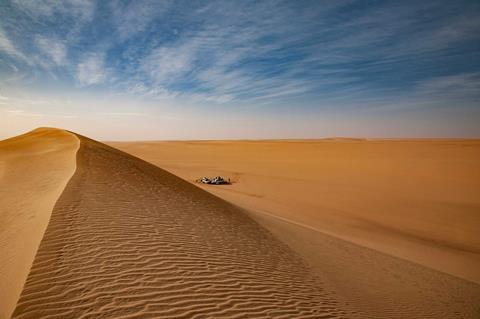
I’ve found that nothing short of fast-water crossings and side slopes worries 4x4 drivers more than driving in sand—even though, unlike the other two, sand driving is very rarely hazardous.
I chalk it up to the peculiarly American horror of getting stuck, as though it represents a failure or, worse, an indictment of one’s man- or womanhood, rather than a perfectly ordinary occurrence when exploring unfamiliar terrain. (By contrast, my British friends celebrate every minor bogging as an excuse to take a break and brew a cup of tea; Australians likewise, although they generally substitute beer. More on this later.)
Many Varieties
The first thing to know about sand is that there are many varieties of it, and a lot of temporary variability in the conditions of each variety.
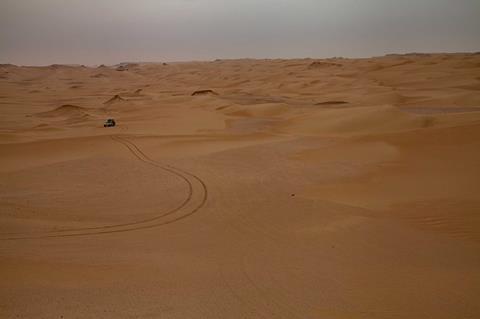
On one end of the spectrum, the sand in arroyos around my home in Tucson is generally so coarse and interlocked that tires barely sink into it. On the other end is Habat, as the Egyptians call it, which we found in the Libyan Desert. Habat is a pool of sand that looks exactly like the drivable stuff all around it, but which is so fine that a vehicle skimming happily along will abruptly plunge right down to the chassis.
In between these extremes is typical dune sand, widespread around the world both on beaches and inland deserts. Dune sand grains are typically between 160 µm and 300 µm (micrometers) or .006 to .011 inches in diameter (that Habat stuff is probably down around 50 µm or .002 inches). Sand of the same diameter in different areas can have varying sheer properties depending on the material (quartz, feldspar, etc.) and how worn the grains are. High sheer strength (rough grains) helps prevent tires sinking.
Even the time of day makes a difference. Typically, sand will be firmer to drive on early in the morning, due to both cooler temperatures and higher humidity. Later in the day, when it’s hot and dry, tires will sink more readily. Sand noticeably damp from a light rain can be quite firm to drive on, while very wet sand acts more like mud and can be treacherous.
Stay On Top
As you might conclude from this so far, successful driving in sand basically involves staying on top of it. Successful recovery from sand basically involves getting back on top of it.

The first and by far the best way to keep your vehicle on top of sand is to air down the tires (another concept many drivers seem to find emasculating). The follow-up question is, exactly how much should you air down?
A lot depends on the weight of the vehicle and what pressure you normally run, but for a “typical” overland vehicle in the 5,000- to 7,000-pound (loaded) range, which might employ street pressures anywhere from 35 to 45 psi, 18-20 psi is a good starting point for fairly firm sand, and don’t hesitate to go down to 14 psi for dune driving.
You can go even lower if necessary, but note that pressures below 8-10 psi greatly increase the risk of unseating a bead if too much throttle or steering is applied—unless of course you have beadlock wheels (such as the clever new street-legal Rebound Pro from Icon Vehicle Dynamics) or internal beadlocks.

How effective is airing down? On one expedition my wife, Roseann, and I helped lead around Egypt’s Western Oases in three Land Cruiser Troop Carriers mounted with very modest 235/85 R16 BFG ATs—hardly anyone’s idea of a “sand tire”—we successfully negotiated several hundred miles completely off-tracks across the Abu Moharek dune chain, the longest in the world. Total times bogged? Two.
By far most of the extra flotation gained when airing down results from the lengthening, not widening, of the tire’s footprint.
However, the sidewalls will bulge with lower pressure, something to be aware of in mixed sand and rock substrate. On that same Egypt trip we ran into a field of kharafish—razor-edged lumps of limestone— and managed to slice open one of the tires.

Drive Gentle
Once you’re aired down and ready to tackle that intimidating beach—or the Sahara—remember the three essential rules of sand driving: accelerate gently, stop gently, and steer gently. If there is any sort of firm surface or crust, you want to avoid breaking through it.
Use a light throttle foot when moving off (automatic transmissions make this easier), and rather than braking to stop simply let the sand slow you so you don’t push a ridge up in front of the tires.
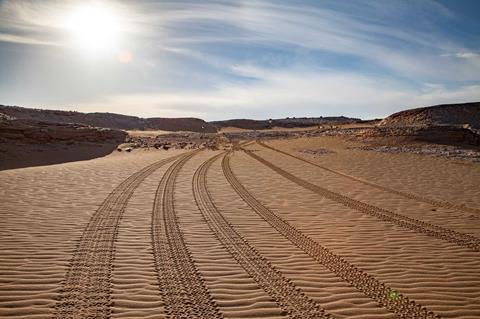
If there are up-and-down slopes, try to stop while pointing downhill to make moving off easier. Likewise, drive straight lines as much as possible, and make your turns as broad as possible. There’s a good rule of thumb for determining how easy progress will be: If you can see the prints of previous tire treads, there is likely solid footing. If all you see are loose grooves, it’s going to be dicier.
Depending on the sand and its condition, your forward progress might help compact the sand and make progress for the rear tires (and following companions) easier, or it might break through the surface and churn the sand.
You’ll be able to tell by the feel, and the look, of the sand behind you. In the former situation, if you have to stop in conditions that might make it difficult to move off again, back up a few feet in your tracks to give the vehicle a bit of a “runway.”
In sand that’s not firmly packed and threatening to suck you down, you’ll need to keep up a good bit of speed to get through soft patches on momentum—not talking 50 mph here, but 20-25-ish.
Generally, you’ll want low range and a gear that keeps engine RPM well up. With an auto box use the manual selector to maintain this. However, the instant you lose momentum and begin to travel downward rather than forward, stop—you’ll do no good trying to force it. If you’ve failed to climb a loose hill, back down and try more speed.
Navigating Dunes
Climbing and descending big, steep dunes is the one area of sand driving that’s somewhat fraught. But as long as you remember to drive straight up and straight down, it’s difficult to get into trouble.
If you don’t know what’s on the other side, scout first—then drive up a different path than where your boots churned the surface.
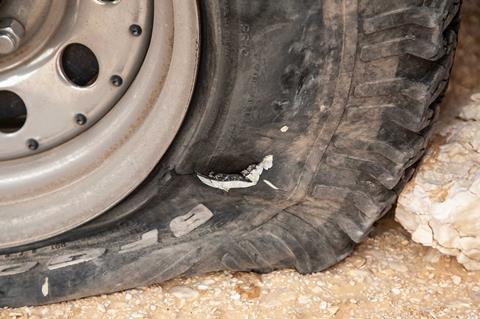
Stay aimed—remember?—straight up, and if you fail back straight down, staying off the brakes and applying throttle if the vehicle begins to slew sideways. Some dunes are firm enough to allow you to stop at the crest to evaluate the descent; on others you need a bit of momentum to get over the crest or it will collapse and high-center you. Do try to avoid Rat-Patrol-like leaps, however.
It’s possible to safely descend terrifyingly steep dune slip faces—nearly as steep as most sand will pack. Disengage hill-descent control if you have it; you don’t want individual brakes engaging. Use low range but not bottom gear; let the sand retard you, and again, if progress slows too much or the rear of the vehicle starts to come around, accelerate to straighten. It’s far better to arrive at the bottom going too fast than to arrive after barrel-rolling three or four times.
Digging Out
What if—perhaps inevitably—you misjudge or just hit a patch of Habat and find yourself immobile and sunk to the axles? It’s time to adopt the British approach: Relax, have a drink (better if not beer), and evaluate before getting into a rush.
It might seem counterintuitive, but the fastest recovery from sand is usually the slowest, because it works the first time. Look under the vehicle. Are all four tires buried? Are any chassis bits also in contact?
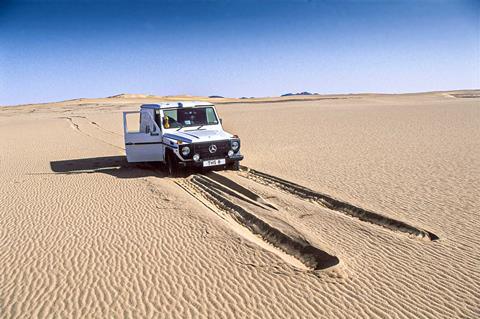
You need to clear it all away and ensure the tires have gentle ramps to power (or be pulled) out of. If deployed, your traction boards should be shoved as far under each tire as possible so the tread grabs immediately without wheelspin (which is bad for composite traction boards, even those with metal studs).
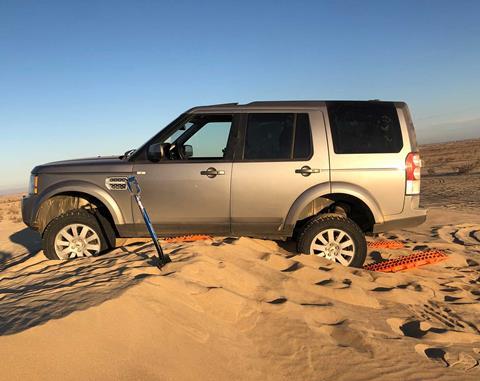
A non-spinning wheel has more grip as well due to static friction. You can either dig ramps down to the bottom, or lift the tires with a jack. If you’ve removed all drag from the sand, you’ll get out the first time. If you need to then keep moving to get away from a soft patch, use leashes on the traction boards so they’ll follow you.
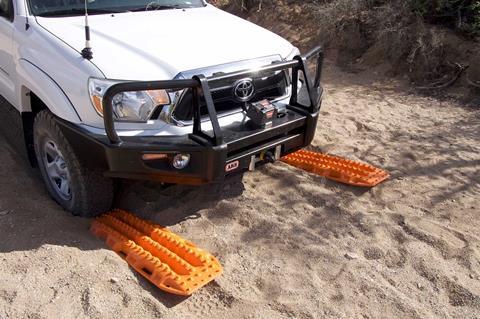
I’ve found assisted recoveries using a KERR rope very effective in sand, since the slack and elasticity allows the recovery vehicle to accelerate slowly, reducing the chance of the tires digging in and spinning. But you still need to ensure the recovered vehicle is free from any drag, or the helping vehicle is likely to wind up buried as well.

What about winching if you’re solo and there are no trees? I’ve had limited success with the Pull Pal anchor (which is also bulky and heavy), and okay success with the Deadman as long as you really bury the thing. The best, as far as I’m concerned, is a spare tire and wheel buried vertically with a trench for the winch line.

Final Thoughts
Driving in sand is one of those situations for which a little preparation combined with a little advance knowledge will rapidly transform you from a trepidatious novice to a confident explorer. With a little practice you’ll feel completely comfortable tackling your local beach… or the Libyan Desert.
Access More Great Stories!
This article originally appeared in OVR Issue 04. For more informative articles like this, consider subscribing to OVR Magazine in print or digital versions here. You can also find the print edition of OVR at your local newsstand by using our Magazine Finder.




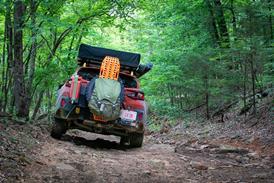
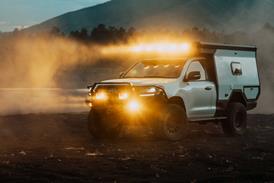
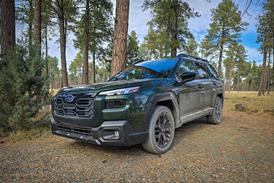
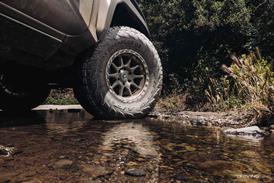
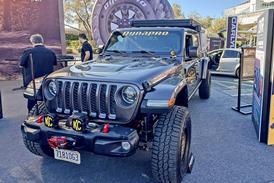
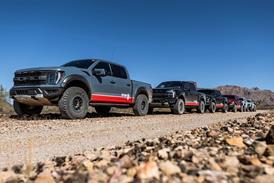
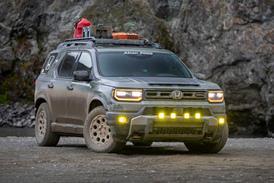
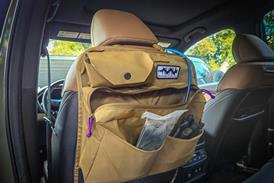

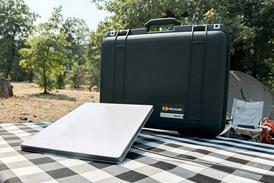







No comments yet